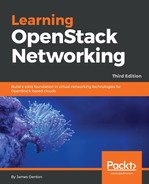With VRRP, a group of routers can be configured to act as a single virtual router. Routers in the VRRP group elect a master to act as the active gateway device, and hosts in the network only need to configure the virtual router address as their default network gateway or next hop address. When a failover occurs, another router in the group will take over routing duties while the configuration of hosts in the network never changes.
In the following diagram, Router A, Router B, and Router C form a single virtual router. In this configuration, each router has its own IP address and the virtual router has its own IP address. Hosts in the network use the virtual router address as their default gateway:

As the master router, Router B in the preceding diagram is responsible for the virtual address 192.168.1.1, and routes traffic for hosts using that address as their gateway. The master router sends VRRP advertisements to the group, which include the priority and state of the master router using the multicast address 224.0.0.18. The backup routers use a variety of timers and configuration options to determine when a master router has failed and change their state accordingly.
